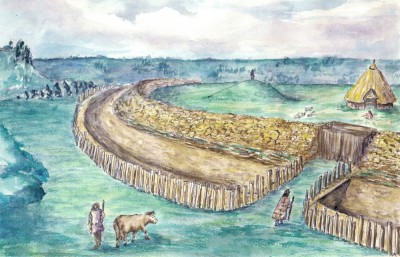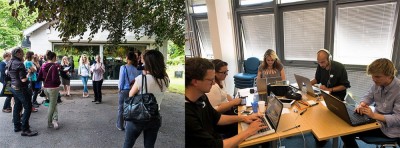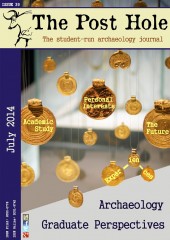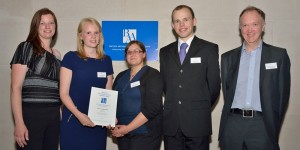University offered the opportunity to diversify my skill set whilst combining my interests in museums, exhibitions, buildings and artefacts within a degree in archaeology. I hoped to pursue an existing passion for art and design alongside studying; however the potential for integrating artistic skills with archaeological knowledge soon presented itself.
Archaeology is the study of the human past through material culture, but how many people would describe the profession as artistic or creative? I have discovered that archaeology and art are interlinked in numerous ways; arguably the process of excavation itself is visual and creative involving self-determined investigation of colour, composition and contextual relationships. A mental image of the past is formed as a result of observation and recording, mirroring an artist's visual expression of their world and interpretations through decisions regarding content, colour and composition. There is a significant difference here in visual output: in contrast to archaeologists, artists continuously express ideas in visual form. Museums house both art and Archaeology, though I believe within a professional context there is a lack of integration between disciplines.
My interest in combining art and archaeology developed within first year. After a recent field school at Boltby Scar Iron Age Hillfort, we presented heritage panels in teams; to which I contributed a site reconstruction painting (Figure 1). I received positive feedback and it prompted me to continue investigating the two disciplines. Subsequently I developed a dissertation proposal to look at site reconstructions from the artist's perspective. Partaking in the module 'Visual Media in Archaeology' highlighted the importance of not only presenting archaeology to the public through exhibition design, but also visualisation and visual media within archaeological processes (including maps, photographs, illustrations and digital technologies).
Clearly we cannot accurately depict the past; however visualisations of what may have been are an important resource. Site reconstructions are a powerful and resonant means of presenting archaeology to the public, and with heritage presentation a key area of archaeological discourse, they should be critically considered. Within my dissertation I argue that the process of creating reconstructions (specifically site reconstructions in traditional artistic media) is one that is overlooked and misunderstood. The process itself is reflexive and intellectually stimulating, it is a research process. It involves an awareness of available evidence, collecting relevant evidence, and experimentation. Visualisations and reconstructions aid archaeological thinking, yet they are often used primarily for end stage presentation after archaeological investigation. There are many theoretical standpoints I discuss within my dissertation alongside qualitative research, and I propose that considering reconstructions from the outset of a project is crucial. I also highlight the need to overcome preconceived views that reconstructions are objective and static interpretations. I investigated the process involved and some of these theoretical issues further through three practical case studies, where I created reconstructions in traditional media and documented my thought processes. In the near future I hope to transfer my qualitative research methodology and documented reconstructive process within a visually dynamic format on my blog at http://archaeologyofpainting.blogspot.co.uk/.
By highlighting the research nature of reconstructions, my conclusions suggest an ideal working method and documentation to form a reconstruction archive (in response to comments by Paul Backhouse, English Heritage). Instigating a widespread mutual understanding of the process by both artists and archaeologists could encourage the use of reconstructions as academic documents. There is also potential for future work, including experimentation of how the reconstructive process could be presented to the public, in turn enabling them to understand archaeology itself.
Without embracing my alternative interests I don't think I would have become as immersed into archaeology as I have. It is a multi-faceted discipline, and I encourage future students to try as much as they can, and use existing skills to their advantage. Through this, I have made lifelong friends and contacts, and had the opportunity to be involved in various projects. A fellow student and I organised and managed an exhibition for the local community at Stillingfleet Church, and through continued involvement with the Teffont Archaeology Project I was asked to be trench supervisor during excavations at Crambeck.
On the 11th July I was able to take part in the Heritage Jam, a first for heritage and visualisation. This was an invaluable experience, enabling me to meet professionals and others with similar interests. It aimed to bring people together, working on the concept of burial. The result of the Jam is an online gallery of work from teams and individuals, showcasing many different perceptions of burial and archaeology; this can be accessed at http://www.heritagejam.org/jam-gallery/. My working group ‘The Inventors’ drew inspiration from York cemetery; after discussing the idea of paths through the cemetery and hidden stories, 'Voices Recognition' emerged - an app that projects simultaneously the voices of those individuals buried. Other members of the team talk about their experience and give more detail about the app in their blog for the Day of Archaeology, available via http://www.dayofarchaeology.com/archaeology-hack-a-thon-the-heritage-jam.... The jam not only resulted in varied and stimulating visualisations, but also promoted the importance of visualisation and art within archaeological practice and digital heritage.
As a mature student, I wasn't quite sure what university would offer, however archaeology has enabled me to find a direction. I will be travelling to Çatalhöyük as a member of the visualisation team, which will be an incredible experience. A masters is a possibility in the future and I aim to continue on the path archaeology has led me, and progress as an archaeological artist.







